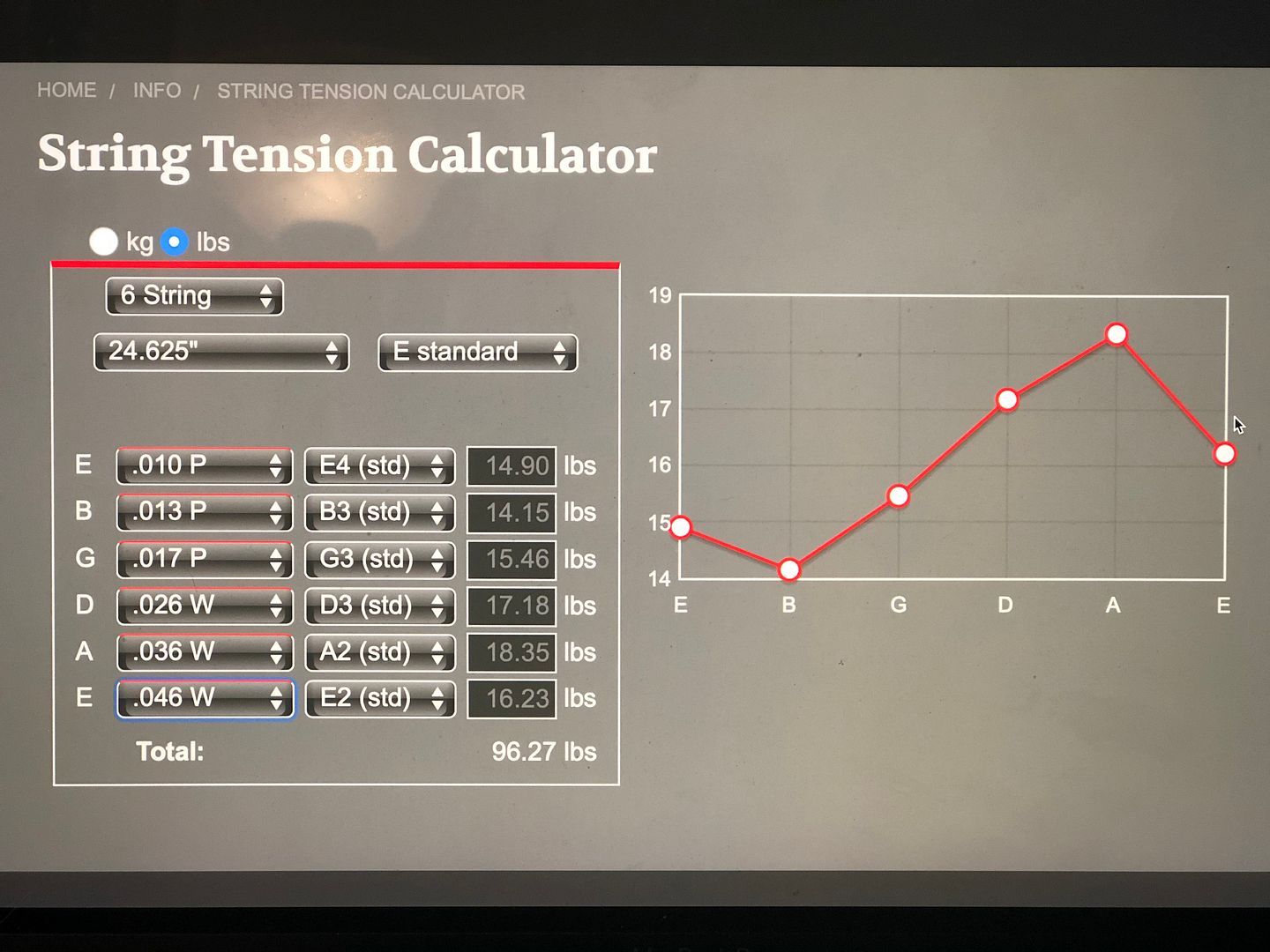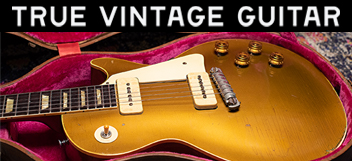marshall1987
Well-known member
- Joined
- Jan 30, 2005
- Messages
- 3,278
My aim here is to objectively assess the characteristics and performance of Gibson's trapeze tailpiece installed on ES-335/345s manufactured from 1965 onward. I break down the subject by delving into practical applications of classical mechanics. Many will be familiar with the basic concepts discussed here, others perhaps not so much. Mercifully, the Readers Digest editorial model is followed as much as possible. Sorry, trick question......
1965 and later Gibson ES- 335s with a trapeze tailpiece can perform and sound just as good as examples with stop tailpieces. To many, they are suitable for a wide variety of musical genres, and when compared side-by-side to the pre-1965 stop-tailpiece models, there are no appreciable differences.
Consider.... the total net force or loading, resulting from the string's tension on a trap-tail 335....using the common set of .010" to .046" electric guitar strings....exerts roughly 96 lb. of force on an ES-335 when tuned to standard. That's nearly 100 pounds. One-hundred pounds of weight is like a Little League baseball pitcher standing on the bottom rim of your guitar.

1. The key concept or "takeaway" here is that guitar strings under tension exert a compression load at the attachment point(s).
2. Newtons Third Law of Motion states: "When one body exerts a force on a second body, the second body simultaneously exerts a force equal in magnitude and opposite in direction on the first body".
3. There is a net force of 96 lbs. which is applied to both the headstock and the guitar's rim where the trapeze is attached. Continuing, the force is transferred into: (1) the mahogany end-block & the maple center block; and, (2) at the headstock ....down the length of the guitar's neck. This is the key to the trapeze tailpiece ES-335s great sound and performance' i.e., NEARLY THE ENTIRE LENGTH OF THE GUITAR ....FROM THE HEADSTOCK ALL THE WAY TO THE BOTTOM RIM......IS UNDER A COMPRESSION LOAD. Here's a thought experiment......Imagine a very large bench vise 42" wide......capable of clamping down on the guitar at it's headstock, AND at the bottom rim....exerting 96 pounds of force on the guitar! That's what is happening with the trapeze tailpiece ES-335.
4. CONTRAST THIS WITH THE STOP-TAILPIECE VERSION; wherein string loading is concentrated, and evenly distributed between the tailpiece bushings & the headstock. With this configuration, a significant length of the maple center-block behind the stop-tailpiece (~8 1/2 inches), IS NOT subjected to loading from the string's tension. Put another way, nearly ONE-HALF of the maple center-block’s entire length; i.e., from just behind the stop tailpiece - to the strap button, has no significant load bearing function. Unlike the trapeze version wherein the entire length (~ 18 inches) has a load bearing function. **Note..for simplicity, I have ignored the effect of the strings' down force at the guitar's nut and bridge, and any opposing forces from the truss rod.
5. String loading forces are what drive a guitar's acoustic (& amplified) response, allowing the guitar to produce sound. Even a layman can appreciate this concept. This is why medium and heavy gauge strings produce a more robust, louder acoustic (& amplified) sound, compared to light gauge strings.
6. A trapeze tailpiece does NOT compromise or hinder the performance, tone, or sustain of an ES-3x5 semi-hollowbody guitar. Just the opposite. I would argue the trapeze tailpiece design heightens and bolsters overall performance of an ES-3x5 guitar in many cases.
7. The key difference between the two types is the manner in which string loading forces are applied to the maple center-block. Both tailpiece versions involve compression loading of the center-block. But first.... a quick primer on compression: from Wikipedia.... "In mechanics, compression is the application of balanced inward ("pushing") forces to different points on a material or structure, that is, forces with no net sum or torque directed so as to reduce its size in one or more directions. It is contrasted with tension or traction, the application of balanced outward ("pulling") forces; and with shearing forces, directed so as to displace layers of the material parallel to each other. " Let's take a deeper look:
a. In the case of the trapeze tailpiece version, loading forces are directed into the end-grain of the center-block via uniaxial compression. In uniaxial compression, the forces are directed along one direction only, so that they act towards decreasing the object's length along that direction. In this case the "object" being compressed is the entire length of the center-block.
b. In the case of the stop-tailpiece, compression loading is directed into the center-block via two embedded anchors comprised of one-inch threaded steel studs mated to individual female bushings inserted perpendicular to the center block, and about 8 1/2" from the guitar's bottom rim. In addition, there is a rotational force applied to the anchors and center-block from the pull of the strings, which introduces a rotational moment defined as as torque. Torque can be thought of as a twist to an object around a specific axis.
8. These factors, & the additional string length behind a trap-tail bridge, presumably account for the perceived difference(s) in performance between a trapeze tailpiece & a stop tailpiece. But to categorically state the stop-tailpiece design is superior in every case is a debunked myth. I think attitudes regarding value & desirability have more to do with the end of Gibson's "Golden Era" (1952-1964/65) which coincided with the transition.
9. It is a misconception & myth that vintage '60s stop-tail 335s are superior (in performance, tone, sustain, touch, etc.) to vintage '65 trap-tail 335s with the wide, 1-11/16" nut. For those who like the narrow 1-9/16" nut, the post 1965 models are more affordable and are very good values. An early '65 big neck, nickel hardware, trapeze 335 is every bit the equal of a similar 1964 stop-tail 335, at nearly one-half the price! Since 2020-21, the price gap is narrowing considerably. I'm told some vintage guitar dealers predict that in 2021 we could see prices on tidy, all-original examples of '65 ES-335s (w/ trapeze, nickel parts, & wide nut) ..... approaching $14k - 15k! But make sure you get one with all-nickel hardware & pickups. It's reported the chrome pickups are wound with poly-insulated wire, not PAF-spec enamel wire. In general chrome hardware will bring down the price somewhat. So you can probably say "goodbye" to the days when you could pick one up for a little as $7.5k - 8.5k.
10. In the final analysis, each guitar must be evaluated on an individual basis for it's strengths and weaknesses. And each guitar player must identify what it is he/she desires and expects from an electric guitar.
1965 and later Gibson ES- 335s with a trapeze tailpiece can perform and sound just as good as examples with stop tailpieces. To many, they are suitable for a wide variety of musical genres, and when compared side-by-side to the pre-1965 stop-tailpiece models, there are no appreciable differences.
Consider.... the total net force or loading, resulting from the string's tension on a trap-tail 335....using the common set of .010" to .046" electric guitar strings....exerts roughly 96 lb. of force on an ES-335 when tuned to standard. That's nearly 100 pounds. One-hundred pounds of weight is like a Little League baseball pitcher standing on the bottom rim of your guitar.

1. The key concept or "takeaway" here is that guitar strings under tension exert a compression load at the attachment point(s).
2. Newtons Third Law of Motion states: "When one body exerts a force on a second body, the second body simultaneously exerts a force equal in magnitude and opposite in direction on the first body".
3. There is a net force of 96 lbs. which is applied to both the headstock and the guitar's rim where the trapeze is attached. Continuing, the force is transferred into: (1) the mahogany end-block & the maple center block; and, (2) at the headstock ....down the length of the guitar's neck. This is the key to the trapeze tailpiece ES-335s great sound and performance' i.e., NEARLY THE ENTIRE LENGTH OF THE GUITAR ....FROM THE HEADSTOCK ALL THE WAY TO THE BOTTOM RIM......IS UNDER A COMPRESSION LOAD. Here's a thought experiment......Imagine a very large bench vise 42" wide......capable of clamping down on the guitar at it's headstock, AND at the bottom rim....exerting 96 pounds of force on the guitar! That's what is happening with the trapeze tailpiece ES-335.
4. CONTRAST THIS WITH THE STOP-TAILPIECE VERSION; wherein string loading is concentrated, and evenly distributed between the tailpiece bushings & the headstock. With this configuration, a significant length of the maple center-block behind the stop-tailpiece (~8 1/2 inches), IS NOT subjected to loading from the string's tension. Put another way, nearly ONE-HALF of the maple center-block’s entire length; i.e., from just behind the stop tailpiece - to the strap button, has no significant load bearing function. Unlike the trapeze version wherein the entire length (~ 18 inches) has a load bearing function. **Note..for simplicity, I have ignored the effect of the strings' down force at the guitar's nut and bridge, and any opposing forces from the truss rod.
5. String loading forces are what drive a guitar's acoustic (& amplified) response, allowing the guitar to produce sound. Even a layman can appreciate this concept. This is why medium and heavy gauge strings produce a more robust, louder acoustic (& amplified) sound, compared to light gauge strings.
6. A trapeze tailpiece does NOT compromise or hinder the performance, tone, or sustain of an ES-3x5 semi-hollowbody guitar. Just the opposite. I would argue the trapeze tailpiece design heightens and bolsters overall performance of an ES-3x5 guitar in many cases.
7. The key difference between the two types is the manner in which string loading forces are applied to the maple center-block. Both tailpiece versions involve compression loading of the center-block. But first.... a quick primer on compression: from Wikipedia.... "In mechanics, compression is the application of balanced inward ("pushing") forces to different points on a material or structure, that is, forces with no net sum or torque directed so as to reduce its size in one or more directions. It is contrasted with tension or traction, the application of balanced outward ("pulling") forces; and with shearing forces, directed so as to displace layers of the material parallel to each other. " Let's take a deeper look:
a. In the case of the trapeze tailpiece version, loading forces are directed into the end-grain of the center-block via uniaxial compression. In uniaxial compression, the forces are directed along one direction only, so that they act towards decreasing the object's length along that direction. In this case the "object" being compressed is the entire length of the center-block.
b. In the case of the stop-tailpiece, compression loading is directed into the center-block via two embedded anchors comprised of one-inch threaded steel studs mated to individual female bushings inserted perpendicular to the center block, and about 8 1/2" from the guitar's bottom rim. In addition, there is a rotational force applied to the anchors and center-block from the pull of the strings, which introduces a rotational moment defined as as torque. Torque can be thought of as a twist to an object around a specific axis.
8. These factors, & the additional string length behind a trap-tail bridge, presumably account for the perceived difference(s) in performance between a trapeze tailpiece & a stop tailpiece. But to categorically state the stop-tailpiece design is superior in every case is a debunked myth. I think attitudes regarding value & desirability have more to do with the end of Gibson's "Golden Era" (1952-1964/65) which coincided with the transition.
9. It is a misconception & myth that vintage '60s stop-tail 335s are superior (in performance, tone, sustain, touch, etc.) to vintage '65 trap-tail 335s with the wide, 1-11/16" nut. For those who like the narrow 1-9/16" nut, the post 1965 models are more affordable and are very good values. An early '65 big neck, nickel hardware, trapeze 335 is every bit the equal of a similar 1964 stop-tail 335, at nearly one-half the price! Since 2020-21, the price gap is narrowing considerably. I'm told some vintage guitar dealers predict that in 2021 we could see prices on tidy, all-original examples of '65 ES-335s (w/ trapeze, nickel parts, & wide nut) ..... approaching $14k - 15k! But make sure you get one with all-nickel hardware & pickups. It's reported the chrome pickups are wound with poly-insulated wire, not PAF-spec enamel wire. In general chrome hardware will bring down the price somewhat. So you can probably say "goodbye" to the days when you could pick one up for a little as $7.5k - 8.5k.
10. In the final analysis, each guitar must be evaluated on an individual basis for it's strengths and weaknesses. And each guitar player must identify what it is he/she desires and expects from an electric guitar.
Last edited:





